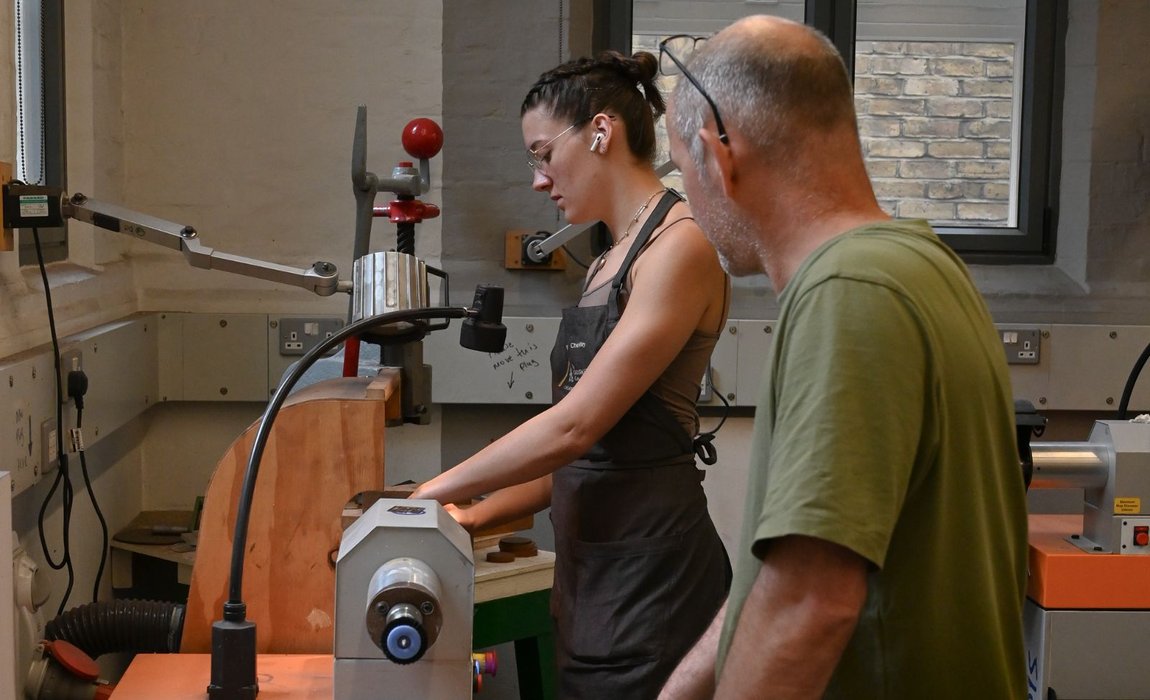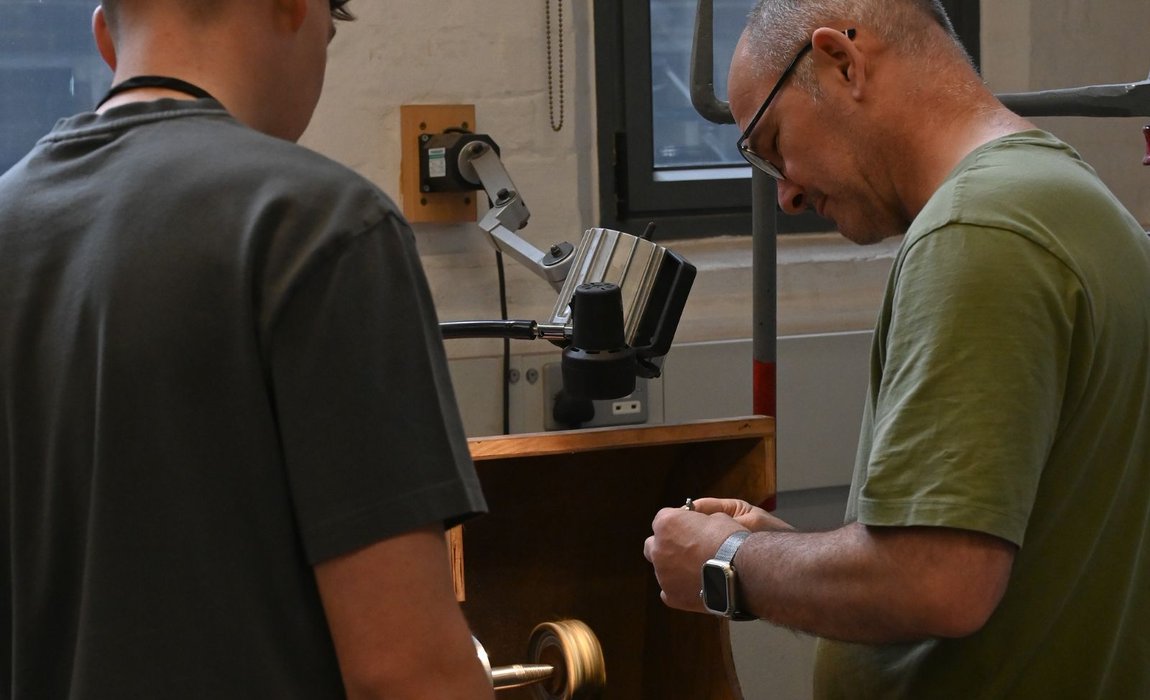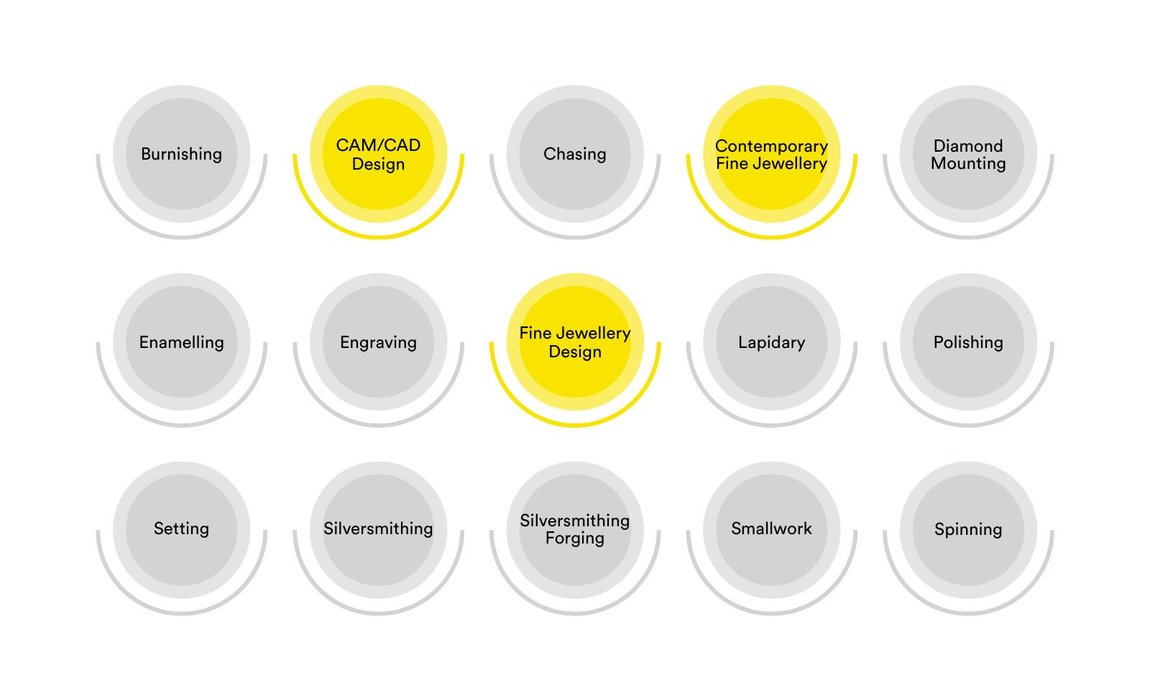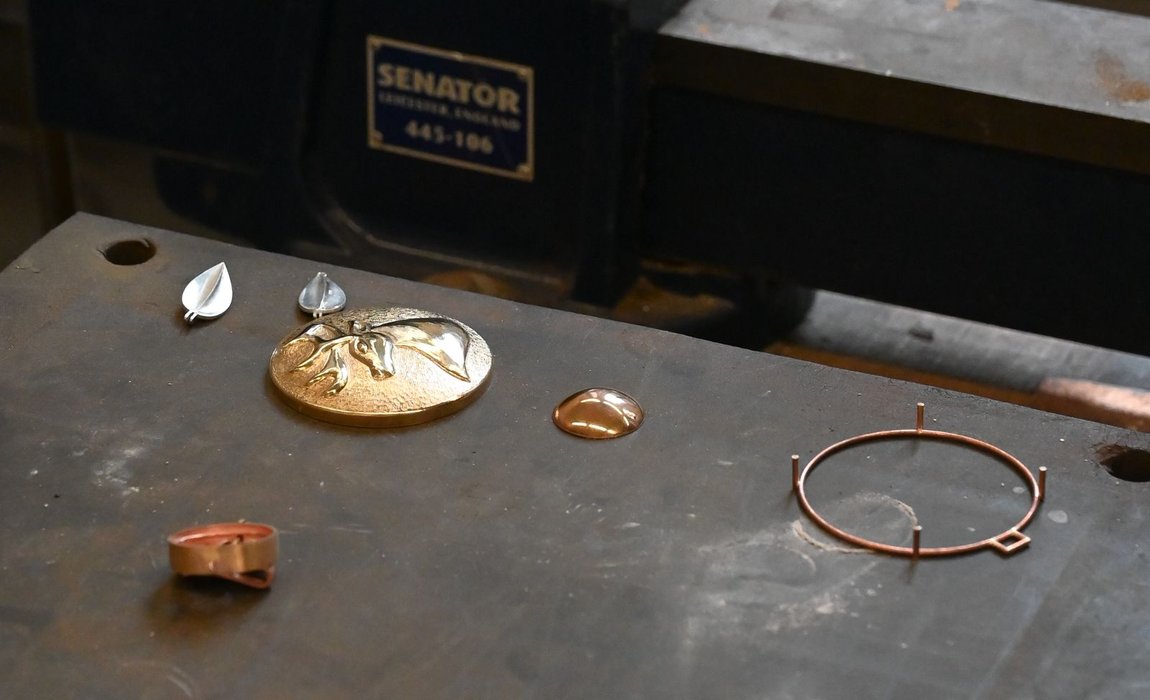The Centre’s response to the skills gap, and how we support those who train
Skills once central to Britain’s jewellery and silversmithing trade are disappearing. Silver spinning, chasing, hand engraving and polishing are now all listed on the Heritage Crafts Red List as endangered or critically endangered. If they are not passed on, they risk vanishing altogether, and with them, vital parts of UK supply chains. The challenge is not only the scarcity of the skills themselves, but also the capacity of businesses to invest in training, because employers must balance teaching time with commercial demands. They face rising costs, limited government support, and the difficulty of recruiting into a sector that too often remains hidden from view.
“The industry knows what it needs,” says Helen Dobson, who manages the Goldsmiths’ Company Apprenticeship Scheme. “The hard part is turning that knowledge into practice and building structures that allow young people to learn while businesses continue to operate.” The Goldsmiths’ Centre’s role is to work with employers and apprentices to find routes that are practical, responsive, and sustainable.

Skills at risk
Since the Centre opened in 2012, just over 100 apprentices have trained through the Goldsmiths’ Company Apprenticeship Scheme. Eighty-four percent are in disciplines on the Red List and fourteen percent of these are in endangered or critically endangered categories. These are not peripheral crafts, but skills that underpin the industry and give work its quality and character.
Some, such as engraving, survive through steady continuity. Engravers Samantha Marsden and James Neville have trained apprentices consistently since the Centre opened. Engraving is an unforgiving craft, it demands patience, precision and repetition. Their commitment shows that endangered skills can endure when training is embedded in the rhythm of everyday workshop life.
“Due to the fast-paced technological world we have entered the demand for our craft has increasingly risen. Hand engraving and the art of the craftsperson cannot be matched or replicated by a machine with all its nuances that hand engraving offers. It is a skill and art that takes time to master and we feel it is important to pass on our skills so that new generations can master and keep the craft alive, producing heirlooms and antiquities of the future. The Goldsmiths' Centre has been at the core of this with support and advice.”
– James Neville explains
Others require deliberate revival. Silver spinning and chasing had not been taught under the scheme since the early 1990s and 2000s, respectively. At Stuart Ray Ltd, both disciplines have been reintroduced with Stuart taking on an apprentice in each discipline. “It’s a four-year apprenticeship for a reason,” Stuart reflects. “Even after that you are still learning. Exposure to smithing, chasing and polishing gives a fuller understanding. It doesn’t mean you know everything, but it deepens your grasp of your specialism.”

Looking to the future, he intends to widen the circle of craftspeople teaching his next apprentice. “More than one trainer, more than one approach. If there’s external training available, we’ll use it. The more perspectives an apprentice has, the stronger their knowledge becomes.” He also argues for shared learning between workshops: “If another business has an apprentice, send them down to us for a few weeks. They’ll learn another way of working. Knowledge should be shared, everybody gains.”
Polishing illustrates the same problem. It is vital to the finish and the feel of a piece of jewellery or silversmithing, yet it rarely attracts apprentices. This October, Thomas Lyte welcomed a new recruit into polishing, only the fourth polishing apprenticeship since the Centre opened. “Over the years, I’ve found it quite challenging to find apprentices interested in our side of the industry” explains polisher Paul Adaway. “Most young people tend to be drawn to silversmithing, and only a few show interest in polishing and finishing. That’s why it’s been such a pleasant surprise to have someone like Isa join us directly in the polishing department. It’s rare and genuinely refreshing to see that kind of enthusiasm for this craft. When Isa joined us, it was clear within just a couple of days that he had the right aptitude and attitude. I’m pleased to say he’s already made excellent progress.”
For Lucy Bushell, HR Manager at Thomas Lyte, apprenticeships form part of a deliberate strategy:
“Our mission is preserving traditional skills and pioneering modern methods. We need a workforce that blends experience with new talent, particularly in rare disciplines. As a vertically integrated company, nurturing skills in-house is essential. Apprentices are our future.”
Business capacity
Employing an apprentice requires a long view. It means committing time and resources to someone still learning, and that impact is keenly felt by small workshops and companies. Yet more employers are making that choice. The October 2025 intake spans silversmiths, diamond mounters, enamellers, contemporary fine jewellers, engravers and polishers. It reflects both heritage and the reality of today’s workshops.
Adapting the framework also matters. Since 2015, three new specialisms have been added to the scheme’s roster of fifteen: Fine Jewellery Design, CAD/CAM Design, and, from 2025, Contemporary Fine Jewellery. The latter updates the traditional diamond-mounting route, incorporating 3D technologies now common in contemporary practice. It was developed in response to employer feedback, ensuring that apprenticeships remain aligned with what workshops actually need.

Alumni play a growing role in this ecosystem, as well. More Journeymen, Freemen within ten years of completing their training, are returning to the Centre as apprentice trainers, vocational consultants and tutors. Two of this year’s new apprentice employers were Centre apprentices themselves, and others are teaching Day Release and short courses at the Goldsmiths’ Centre. Bringing alumni into other parts of the Centre’s activities strengthens the training culture, builds the training community of the future, and gives fresh insight and energy.

The same principle underpins the Jewellery Foundation Programme, launched in September 2025. It prepares trainees for skilled roles, either through apprenticeships or direct entry, but does so with a firmly industry-facing design. “The Jewellery Foundation Programme provides the Centre with several opportunities beyond preparing our trainees for progression into skilled and meaningful jobs within our industry,” says Chris Oliver, Head of Professional Training. “We are delighted to have created a platform for industry endorsement, both nationally and internationally, through Stephen Webster, The Goldsmiths’ Craft & Design Council and A Thousand Facets. They are not only demonstrating their support for skills training but helping create meaningful industry relevant project briefs for our trainees to aspire to. In addition to the industry endorsement we are proud to be welcoming back our own alumni, who are skilled craftspeople in their own right, to include them as part of the Centre’s teaching team allowing them to develop and refine their own teaching but doing this alongside our experienced tutors. This underpins our ethos that now and in the future our training will be delivered by individuals who are working within the industry helping to retain and develop its relevance.”
How the Centre connects
The Centre cannot save skills – its role is to connect and support those already committed to passing them on through:
- Structured routes that balance bench time with learning.
- Pathways shaped by employer feedback, updated for relevance.
- Alumni engaged as trainers and consultants.
- Early, accessible entry points for young people, from schools through to foundation level.
- Visibility and advocacy to show the cultural and economic value of craft.
- Research that highlights bottlenecks and directs effort where it is needed most.
Looking ahead
Endangered skills can disappear quietly: a retirement here, a workshop closure there, a few years without an apprentice. But they can also recover. Employers who choose to train, apprentices eager to learn, alumni willing to teach, and an organisation able to connect the parts can, together, make a chain strong enough to hold the future of the craft together.
The Goldsmiths’ Centre’s task is to keep that chain joined. The survival of craft depends on shared responsibility, but also brings shared reward - a resilient industry, equipped with the hand skills and knowledge that will carry it forward.